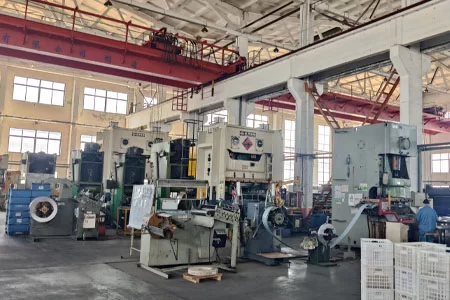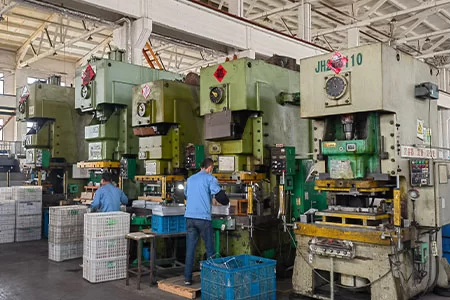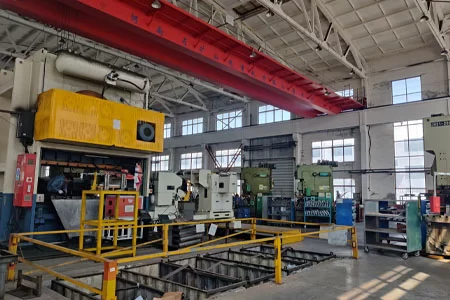This comprehensive blog post demystifies the "U" unit in network server accessories—the standard measurement that defines the height of equipment in server racks. We explain what 1U, 2U, 18U, 42U, and other configurations mean, discussing precis

Decoding Rack Units: Your Essential Guide to Understanding 1U, 2U, and Beyond
1U, 2U, … 18U, 42U: What Do They Mean?
-
Home>
-
Blog>
-
Technology>
1U, 2U 18U, 42U, What That Mean
Decoding Rack Units: Your Essential Guide to Understanding 1U, 2U, and Beyond
1U, 2U, … 18U, 42U: What Do They Mean?
This comprehensive blog post demystifies the "U" unit in network server accessories—the standard measurement that defines the height of equipment in server racks. We explain what 1U, 2U, 18U, 42U, and other configurations mean, discussing precise dimensions, tolerances, and essential parameters. In addition, we explore how these measurements impact cooling, cable management, and overall data center design.
The Foundation of Modern Data Centers
When you step into a modern data center, you're immediately struck by the sight of neat, uniform racks filled with servers, switches, and various network devices. However, behind this seemingly simple arrangement lies a standardized system that dictates every piece of equipment's design and functionality. At the heart of this system is the "U" a unit of measurement that has become the backbone of network server accessories.
A "U" is more than just a number; it is the universal language that defines the vertical space available in a rack. Standardized at 1.75 inches (44.45 mm), the "U" unit ensures that every component, whether it's a 1U server, a 2U storage unit, or a 42U full-height rack, fits together perfectly. In this article, we will explore what these different "U" values mean, why they matter, and how they influence every aspect of data center design. We will also delve into the technical parameters behind these measurements and examine how HULK Metal's advanced manufacturing capabilities empower us to produce high-quality network server accessories that adhere to these standards.
The Origin and Evolution of the "U" Unit
Historical Context
Before the advent of the standardized "U," early computer systems were bulky and often occupied entire rooms. As technology advanced, the need for a more efficient and compact design led to the development of rack-mounted systems. Engineers and IT professionals quickly realized that a standardized measurement was necessary to ensure compatibility between different manufacturers and to maximize the use of available space. Thus, the "U" was born—initially as a rough guideline, and later as the universally accepted measurement of 1.75 inches in height.
Why Standardization Matters
Standardization brought order to the chaotic world of early server designs. With every manufacturer adhering to the 1U standard, it became possible to design server racks that could hold a variety of equipment without worrying about mismatched dimensions. This uniformity not only simplified installation and maintenance but also paved the way for innovations in cooling, cable management, and overall system efficiency. Today, data centers rely on the "U" unit to maintain consistency and ensure that every component is both functional and aesthetically aligned.
The Modern Rack: 1U to 42U and Beyond
In today's data centers, you'll commonly encounter configurations such as 1U, 2U, 4U, 18U, and even 42U racks. A 1U server takes up 1.75 inches of vertical space, while a 2U server occupies 3.5 inches, and so on. Full-height racks, often rated at 42U, provide ample space to house an array of servers and accessories. Understanding these measurements is crucial for effective space planning and for ensuring that your data center operates at peak efficiency.
Technical Specifications of the "U" Unit
Defining the "U"
At its core, a "U" is defined as exactly 1.75 inches (44.45 mm) in height. This dimension is used globally to standardize the size of network server accessories. When you purchase a server or any accessory, its height will be described in "U's," ensuring that it will fit into a standard rack without the need for custom adjustments.
Key Parameters and Tolerances
Precision is paramount when it comes to the design and fabrication of network server accessories. The following parameters are critical:
Thickness:
Components such as server trays, mounting brackets, and blank panels are typically manufactured with metal thicknesses ranging from 1.5 mm to 2.5 mm. For example, a common specification might be a 2.0 mm thick component, which provides an optimal balance between rigidity and weight.
Width and Depth:
Standard accessories are designed to fit within the confines of a typical server rack. Common widths range from 450 mm to 600 mm, and depths can vary from 600 mm to 1200 mm. For instance, an accessory designed for a 2U server might measure 600 mm wide and 800 mm deep.
Tolerance:
High-precision manufacturing processes are used to maintain tolerances as tight as ±0.2 mm. This level of precision ensures that every component fits seamlessly into a rack, without gaps or misalignments.
Ventilation:
Many network server accessories incorporate ventilation features such as perforations or slots. Typical perforation sizes range from 5 mm to 10 mm in diameter. These features are designed to promote airflow and help dissipate heat generated by high-performance equipment.
Load Capacity:
Accessories must also be capable of supporting significant weight. Many U-based components are engineered to handle loads of up to 50 kg, ensuring that even densely populated racks remain stable.
Measuring U in Practice
When designing a server rack, the total available height is divided by the height of a single U (1.75 inches) to determine how many U's can fit into the rack. For example, a 42U rack provides 42 x 1.75 inches = 73.5 inches of vertical space. This standardized measurement makes it easy for IT professionals to plan the layout of their equipment and to ensure that each component fits as intended.
The Significance of Different U Configurations
1U and 2U Servers: Compact Yet Powerful
A 1U server is one of the most common configurations in data centers. Occupying only 1.75 inches of vertical space, 1U servers are designed for environments where space is at a premium. They are often used in high-density configurations, providing impressive processing power while maintaining a compact footprint. In contrast, 2U servers, which occupy 3.5 inches of space, generally offer additional expansion slots, increased cooling capabilities, and more robust hardware. Both configurations have their advantages:
1U Servers:
Pros: Space-saving design, cost-effective, ideal for large-scale deployments.
Cons: Limited expansion capabilities and sometimes less cooling capacity compared to larger units.
2U Servers:
Pros: Greater flexibility with expansion, improved cooling, and better performance for demanding applications.
Cons: Require more vertical space, potentially reducing the overall density of the data center.
Mid-Range Options: 4U to 18U
As server requirements become more complex, mid-range configurations such as 4U, 6U, 8U, and even 18U systems are increasingly popular. These sizes offer a balance between density and performance, allowing for more robust cooling solutions, additional storage options, and enhanced processing power. For instance, a 4U server might be used in environments that demand high performance but still need to conserve space, while an 18U rack is often employed in larger installations where scalability is critical.
Full-Height Racks: The 42U Standard
The 42U rack is considered a full-height server rack and is one of the most common configurations in enterprise data centers. A 42U rack offers a total of 73.5 inches of vertical space, allowing for the installation of a wide variety of components—from servers and storage units to network switches and power distribution units. The 42U configuration is ideal for environments that require maximum scalability and flexibility. Its large capacity enables IT professionals to plan for future expansion without the need for immediate reconfiguration.
How U Configurations Affect Data Center Design
Understanding the various U configurations is essential for efficient data center planning. The choice between a 1U, 2U, or even a 42U rack depends on several factors:
Space Constraints:
Smaller U configurations allow for higher density in limited spaces, while larger units provide more room for expansion.
Cooling Requirements:
Proper airflow is critical in high-density environments. Smaller units may require additional cooling solutions to prevent overheating.
Scalability:
Future-proofing your data center means planning for growth. Full-height racks like the 42U configuration offer the most flexibility for adding new equipment over time.
Cost Considerations:
While high-density configurations can reduce initial hardware costs, they may also require investment in more advanced cooling and power management solutions.
By carefully evaluating these factors, IT professionals can design a data center that not only meets current demands but is also ready to scale as technology evolves.
Integration of U-Based Accessories in Network Server Systems
The Role of Network Server Accessories
Network server accessories encompass a wide range of components, including blank panels, mounting brackets, cable management systems, and cooling solutions. Each of these components is designed with the "U" unit in mind to ensure seamless integration into server racks. For example:
Blank Panels:
Often used to cover unused spaces in a rack, these panels help maintain airflow and security.
Mounting Brackets:
Designed to secure servers and other equipment, these brackets are engineered to handle the specific dimensions dictated by the "U" unit.
Cable Management Systems:
Efficient cable routing is crucial for maintaining optimal airflow and reducing clutter. U-based channels and clips are used to organize cables neatly within the rack.
Key Parameters for Accessories
When designing network server accessories, manufacturers must consider the following parameters:
Precision Dimensions:
Every accessory must adhere to the standard U measurements, with dimensions carefully controlled to ensure compatibility.
Tolerances:
Maintaining a tolerance of ±0.2 mm is essential for ensuring that accessories fit perfectly within the rack.
Material Strength:
Accessories must be robust enough to support heavy equipment while remaining lightweight enough for ease of installation.
Ventilation Features:
Many accessories incorporate ventilation slots or perforations to facilitate proper cooling.
Customization Options:
Clients may require accessories with specific features, such as integrated cable management clips or custom finishes, which must be seamlessly integrated into the design.
How U-Based Accessories Enhance Data Center Performance
The integration of U-based accessories has a direct impact on data center performance:
Improved Airflow:
By maintaining a uniform design standard, accessories help ensure that air flows evenly through the rack, preventing hot spots.
Enhanced Security:
Accessories such as blank panels and mounting brackets protect sensitive equipment from unauthorized access and physical damage.
Optimized Space Utilization:
Standardized U measurements allow for precise planning of equipment layout, ensuring that every inch of vertical space is used efficiently.
Simplified Maintenance:
With components designed to fit perfectly, installation and maintenance become more straightforward, reducing downtime during upgrades or repairs.
Manufacturing Excellence: How HULK Metal Delivers Quality
Advanced Production Capabilities
At HULK Metal, we leverage state-of-the-art metal processing and sheet metal fabrication techniques to produce network server accessories that adhere to the strictest industry standards. Our production capabilities include:
Precision Laser Cutting and CNC Bending:
These advanced processes allow us to achieve dimensional tolerances as tight as ±0.2 mm, ensuring every component fits perfectly into standard server racks.
Automated Stamping and Forming:
Our facilities are equipped with high-speed automated systems that can handle both small-batch prototypes and large-scale production runs without sacrificing quality.
Integrated Quality Control:
Every stage of production—from raw material inspection to final testing—is monitored closely to ensure that all products meet our rigorous quality standards.
Custom Contract Manufacturing
HULK Metal specializes in providing custom contract manufacturing services for a wide range of network server accessory models. We have the expertise and capacity to produce components in various U configurations—from 1U and 2U systems to full 42U racks—tailored to the specific needs of our clients. Our integrated supply chain ensures timely delivery, and our commitment to precision guarantees that every product is built to last.
After-Sales Support for Quality and Shipment Issues
In addition to our advanced manufacturing capabilities, HULK Metal offers comprehensive after-sales support. Should you encounter any issues related to product quality or shipment shortages, our service team is ready to provide prompt returns, exchanges, or replenishments. This commitment ensures that your operations remain smooth and that any issues are resolved quickly, allowing you to focus on what matters most—running your data center efficiently.
Conclusion: The Importance of the "U" in Modern Data Centers
The "U" unit is more than just a measurement—it is the cornerstone of network server accessory design. From 1U and 2U servers to full 42U racks, every component in a data center is built around this standardized unit. Understanding what these configurations mean and how they influence design, cooling, cable management, and scalability is essential for anyone involved in data center planning and operations.
HULK Metal is proud to offer advanced contract manufacturing services that deliver high-quality U-based network server accessories. With our state-of-the-art production capabilities, rigorous quality control, and comprehensive after-sales support for any quality or shipment issues, we provide solutions that help data centers run efficiently and reliably.
As the demands on data centers continue to evolve, the role of standardized units like the "U" will remain crucial. Whether you're planning a new installation or upgrading an existing facility, understanding these parameters will enable you to make informed decisions that optimize performance, save space, and ensure long-term reliability.
This comprehensive guide has explored the meaning behind 1U, 2U, … 18U, 42U in network server accessories, detailing technical specifications, design considerations, real-world applications, and future trends. By understanding the standard "U" unit and its impact on data center design, you are better equipped to maximize efficiency and scalability in your infrastructure. With HULK Metal's advanced manufacturing capabilities and unwavering commitment to quality, you can confidently build or upgrade your data center with accessories that meet the highest industry standards. Every "U" counts—and with the right solutions, your network server environment can achieve unparalleled performance and reliability.
This article aims to provide IT professionals, data center managers, and industry enthusiasts with a deep dive into the significance of the "U" unit, ensuring that every technical detail is clear and actionable. From historical context to future trends, our goal is to empower you with the knowledge to design a more efficient, scalable, and high-performing data center.
Article Navigation
Article Navigation
Industries
Foundries






